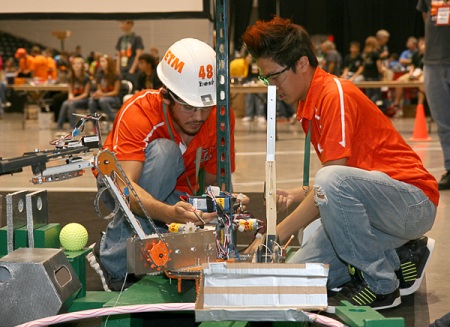Nov 15 2012
Boisterous crowds, pep bands and school mascots are staples of athletic events, but they found a different point of pride during a recent event that placed science and engineering at the center of attention.
 Eduardo Gonzalez (left) and Byung Ki An from the United High School Engineering and Technology Magnet in Laredo prepare their robot to climb a simulated space elevator.
Eduardo Gonzalez (left) and Byung Ki An from the United High School Engineering and Technology Magnet in Laredo prepare their robot to climb a simulated space elevator.
UT Dallas sponsored and hosted the 2012 Texas BEST Regional Robotics Championship at the Curtis Culwell Center in Garland on Nov. 10. Fifty-eight teams of middle- and high-school students from Texas, New Mexico and Arizona qualified to participate in the event.
“Let’s face it, robots are cool,” said Dr. Ken Berry, regional director of Texas BEST and assistant director of the Science and Engineering Education Center (SEEC), one of the UT Dallas event hosts. “These kids start with a box of parts, and six weeks later they’ve gained technical knowledge about robotics, electronics and engineering, and also have learned how to work collaboratively and solve problems. Plus, they get some marketing and presentation experience. These are real-world skills, and they’re having a blast doing it.”
Each competitor set out to construct a remote-controlled robot that could first climb about 10 feet up a metal pole, which was meant to simulate a space elevator made of carbon nanotubes. Then, each robot had to complete a set of specific tasks on a mock space station, with some tasks resulting in more points. Among the tasks to be completed: remove waste cargo (whiffle balls), retrieve and store fuel tanks (2-liter bottles), and install solar panels and a habitation module (made from foam insulation).
Each team qualified to the Dallas-area competition by first competing in a local, or “hub” contest. The teams built their robots over six weeks, starting with a standard BEST robotics kit that contains bits and pieces of electronics and construction materials. Students were allowed to add some of their own touches, within strict guidelines.
Teams approached the challenges of the competition from a variety of perspectives and strategies.
“Trial and error is a waste of time. We worked out the physics first,” said Luis Macias, a member of the team from the United High School Engineering and Technology Magnet (UETM) in Laredo.
The UETM team brought 51 people from Laredo, including an orange-clad cheering section, drum corps and a giant school flag.
A team from the Hockaday School in Dallas was the only all-female team in the field.
“Our strategy was to find a task to complete that would give us the most points,” said Hockaday’s Megan Neal, who drove the team’s robot with a remote control device. “We chose to go for the bottles.”
The Hockaday team also focused on its engineering notebook. The log documents the process the team used to design, build and test its robot, as well as efforts to make the robot “marketable” to potential “buyers.”
“If we want to sell our robot as a product, we wanted it to be diverse and marketable, so we added a telescoping feature to grab bottles,” said team member Gillian Meyer.
The robots could be no more than 24 inches on each side. However, once a match began, the robots were allowed to “unfurl” to any size through their own power.
Awards were presented in several categories. The top prize overall went to the SAIL Home School team from Collin County, which received the first place BEST Award. Considered the highest achievement of the tournament, this award is based on criteria including sportsmanship, teamwork, creativity, school and community involvement and the application of the engineering design process.
The Game Competition Award went to a team from Birdville Center of Technology and Advanced Learning in North Richland Hills, which received the most points in the game portion of the contest. The award was sponsored by Texas Tech University’s Edward E. Whitacre Jr. College of Engineering.
Other categories included creative robot design, project engineering notebook, team spirit and sportsmanship, marketing presentations, and team T-shirt designs, as well as kudos for the most elegant, the most robust and the most photogenic robots.
The Texas Championship is one of three regional competitions sponsored by BEST, which stands for Boosting Engineering, Science and Technology. The organization’s mission is to engage and excite students, as well as to inspire them to pursue careers in STEM fields – science, technology, engineering and mathematics.
The event was hosted by SEEC and UT Dallas’s Erik Jonsson School of Engineering and Computer Science. Sponsors of the event were Texas Instruments, Lockheed Martin, Raytheon, Ericsson, Rockwell Collins and Texas Tech. The national corporate sponsor was MathWorks.